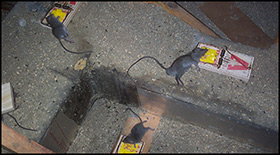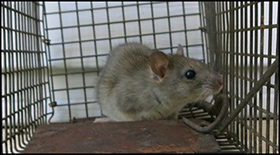Rat Control of Denver
Welcome to Rat Control of Denver! We are Colorado rodent control specialists. Our specialty is rat and mouse control. Our special 32-point process is the single most effective method in the country for permanently solving rodent problems inside houses and buildings. We are not a typical pest control Denver rodent exterminator company that treats rodents in a similar way to insects, with repeated monthly or quarterly poison treatments. That's a never-ending process. We solve the problem ONCE, and PERMANENTLY, by thoroughly inspecting every component of your building and completely sealing shut all access points, to 100% rodent-proof your house. We physically trap and remove all rats or mice, a process that is completely effective once all access has been closed. The problem is soved forever, usually in a week or less. Click on our Denver Prices page to find out more about our prices for rat control work. Or give us a call any time to schedule an appointment, usually within the next day. We look forward to hearing from you.

Denver Rat Trapping

Rodent-Proofing Repairs

Humane Exclusion Options
Call 24/7 to discuss your rat problem.
Same-day or next-day appointments: 303-557-5912
32-point inspection of your property.
Written estimates for rat project.
Fully Colorado licensed and insured.
Rat-proofing repairs with steel.
100% of rodents trapped and removed.
Chewed wire and damage repair services.
Rat dropping cleanup and sanitation services.
Poison-free rodent control methods.
Our Service Range - 303-557-5912




Well, it is important to understand that these animals live in large groups. You may see only one rat, but there are more. They may be hiding in your attic or in other dark corners of your house, but there are almost always more.
The type of equipment needed to get rid of rats varies a bit with the method and location. For instance, will you use wooden snap traps to kill them or are you planning on relocating the rats you trap? You will need to decide this first.
You should also take note that in order to effectively control the rat population, you must locate and seal up all entry points in your home. Otherwise, they will return with friends and family!
First Things First
The first thing to do is to locate and seal the entry points. For this you will need a ladder, hammer and nails. You will also want to ensure you have a metal flashing and some steel mesh. Rats can flatten them selves to fit into a hole the size of a quarter and sometimes even smaller.
The ladder will allow you to inspect the roof as well as high areas around soffits and louvers. The metal flashing and steel mesh is used to seal the small holes you find in the area. Rats have a constant need to chew and they can gnaw through most materials. It is also a good idea to wear gloves for this process in case you encounter a rat or a nest.
Moving On
For the trapping and removal process you'll need more than a dozen traps and bait for each of them. You'll also need a HEPA filter mask, thick gloves and a large Ziploc bag or container with lid to dispose of the carcasses.
It's a good idea to educate yourself on rat behavior. This will help you decide where to put the traps and how to bait them. Once the traps have been placed, they should be checked every eight hours.
As you systematically dispose of the rat carcasses, place them in a Ziploc bag or sealed container. You'll want to dispose of them outside the home in trash bin that has a secure lid.
After Removal
After the rat population has been contained and eliminated you will need to begin the clean up process. This is an in-depth process that requires protective equipment and special cleaning agents. There are specific steps to cleaning up after rats effectively.

